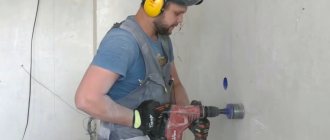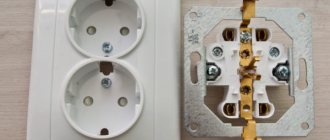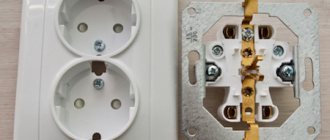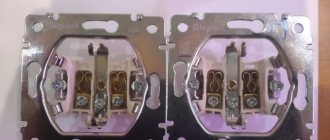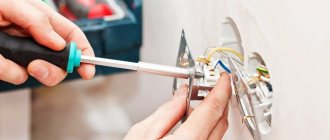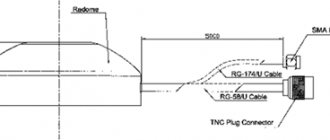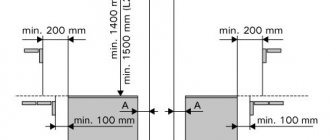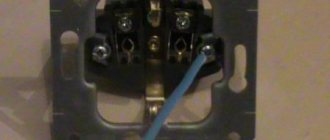A DIN rail socket is a device in the form of a monoblock plug connector with standardized grips for a DIN rail for installation in a distribution panel.
This product, in its design and functional features, resembles a conventional electrical socket with a width between contacts according to the Euro standard.
The only significant difference is that it is designed to connect lighting and other electrical equipment directly to the electrical panel. A regular outlet cannot be installed in such places.
Main purpose
The electrical panel consists of a number of modular devices (switches, automatic machines, indicators, sockets, etc.), each of which performs a specific function.
The panel socket is mounted in an electrical panel to allow connection of any electrical appliance to it during maintenance and repair of switchgear elements. Such an outlet is often used to connect electricity consumers located close to the switchboard. Often, during a control inspection of equipment, portable lamps are also connected.
The DIN rail socket is installed in buildings of various enterprises and office premises of large companies to create reliable electrical contact with the power plug of a device of any power during the arrangement of mock-up pavilions, test benches, etc.
Criterias of choice
In most cases, today, modern power tools are used, equipped with European standard plugs, so experts definitely recommend using a product equipped with a grounding contact.
According to the rules for the design of electrical installations, a grounding loop must be provided at any civil or industrial facility, however, this is not always the case, especially when it comes to converted residential and public premises into industrial premises.
According to Soviet standards, at such facilities, a grounding loop was not provided; instead, grounding was performed.
If this is exactly the situation, then it is better to use an outlet without grounding, or not to ground the one that should be grounded.
For industrial premises, where the connection of portable equipment is often required, the choice is made in favor of a device without grounding , since among the variety of equipment there will certainly be a sample with a Soviet plug.
You can use any type of socket; as a rule, here such connection points are used for portable lighting.
Types of DIN rails
DIN rail is a special metal profile (steel, AL, Cu), which is used as a generally accepted fastening device for installation and dismantling (if necessary) of plug sockets, electric meters, differentiated machines, circuit breakers and other electrical devices.
The rail was named DIN in honor of the German Institute for Standardization, where it was developed. This generalized standard is a basic document that is referenced in the manufacture of electrical devices in almost all countries of the world.
DIN rails are standardized in size and have holes or notches for fastening the product or dividing it to obtain a certain length.
Reiki are classified into the following types:
- Rack type Ω. This is a frequently used fastening structure, resembling the letter Ω in a side section. Many modular devices, including panel sockets, are mounted on a TN 35 rail, where 35 mm is the width of the rail strip. To fasten the terminals, similar strips of reduced overall dimensions are used.
- Rail type C. Products in this category are C-shaped. They are widely used for fastening electrical installation products intended for connecting wires (terminal blocks).
- Rail type G. The profile of this product resembles the letter G in appearance. The main area of application is fastening hardware clamps.
Installation of light switches
| Installation of a single-key switch | PC. | 180 rub. |
| Installation of an external single-key switch | PC. | 230 rub. |
| Installation of a two-key switch | PC. | 270 rub. |
| Installation of an external two-key switch | PC. | 400 rub. |
| Installation of a pass-through switch | PC. | 650 rub. |
| Installation of a pass-through external single-key switch | PC. | 450 rub. |
| Installation of a walk-through external two-key switch | PC. | 650 rub. |
| Installation of an internal single-key switch | PC. | 350 rub. |
| Installation of an internal two-key switch | PC. | 400 rub. |
| Installation of a pass-through internal single-key switch | PC. | 750 rub. |
| Installation of a pass-through internal two-key switch | PC. | 800 rub. |
| Installing a dimmer (dimmer) | PC. | 380 rub. |
| Replacing switches | PC. | 180 rub. |
| Installation of switch block | PC. | 450 rub. |
| Installation of floor electrical hatches | PC. | 350 rub. |
| Dismantling the switch | PC. | 150 rub. |
Design and characteristics
A special feature of the internal structure of panel sockets on a DIN rail is a plastic latch, thanks to which the device is securely attached to an additional profile - the rail.
There are several types of modular sockets:
- No grounding. Small in size, 17.5 mm wide, which means they take up the space of 1 standard module in the panel. This is their main advantage. Used to connect electrical appliances that do not require grounding and low power: soldering irons, lamps, etc. Rated current 6A, 10A.
- With grounding. Their width is much larger than ungrounded ones, amounting to 2.5 modules. Due to the fact that such sockets are equipped with grounding contacts, their use extends to connecting devices with metal components that require grounding. The current parameter is 10A and 6A.
Attention! Powerful electrical appliances cannot be connected to an outlet without grounding!
Modular sockets are divided according to the degree of protection from harmful factors such as moisture and dust. The value is indicated in alphanumeric form. For example, the code is IP44, where IP is the level of protection against the penetration of foreign elements of any size into the device’s body, and 44 is the degree of its moisture protection.
Note! If a DIB socket is installed in a residential switchboard, then it is sufficient that its protection level is at least IP20. If the device is located in unfavorable conditions - on the street, in a smoky or damp room, then the degree of protection of the device must be at least IP44.
The dimensions of modular sockets are set by the world standard and are in the following range:
- length (with ground): 44 mm, 18 mm;
- height (with or without grounding): 45 mm;
- distance between edges: 76 mm, 77 mm;
- thickness: 64 mm, 66 mm.
How to create a diagram
Before starting the layout, they draw up a plan for supplying the house with electricity, taking into account all the individual lines and powerful units, which are assembled into groups.
- Powerful users consuming more than two kilowatts are grouped. An automatic machine that can withstand the specified loads is installed on each line.
- Dishwashers, washing machines, and air conditioners that require little power are connected to circuit breakers rated at 16 A. Choose a cable with a cross-section of 2.5 mm².
- High-power units will require 25 A circuit breakers; the cross-section of the power cable is increased to 4.6 mm². Such lines are carried out with one whole wire.
- For sockets, circuits are drawn for each room, a three-core wire with a cross-section of 2.5 mm² is designed. Individual branches are placed on the socket in distribution boxes.
Lighting devices are divided into groups, connected to one 1.5 mm² cable, the line will require a machine with an input of 10 A.
Design requirements
No categorical standards have been developed regarding filling the shield with modules, but there are some rules. It is logical to place the input switch in the top row , at the beginning, in front of other breakers.
Installation
Before you begin installing an electrical socket, you need to make sure that the parameters of the socket correspond to the power of the equipment that is intended to be connected.
If the socket is installed on a small electrical panel of a house or apartment, then the rated current is quite acceptable 6A, 10A. If a modular device is installed to power powerful electrical appliances required when performing construction or repair work, then its rated current must be at least 16A.
As an example, let's take a Bemis 1/16A grounded electrical socket with a degree of protection IP44. The durable plastic case corresponds to a high level of protection, which makes it possible to use Bemis 1/16A in production.
Sequence of installation of a modular electrical socket:
- Using a screwdriver, pry up the movable part of the plastic clip.
- Place the socket on the rail profile and release the clamp. A click indicates that the latch is secured, which means the socket is locked.
- Start connecting three wires to it: phase, neutral and ground.
Preparing tools
Installation of the shield is not complete without power tools. The wires in the walls are laid in grooves, to form which they take a wall chaser or a grinder with a circle on the stone. Small volumes are made with a chisel and hammer.
The cabinet is attached to a concrete or brick wall with dowels, so you will need a hammer drill and drills with pobedit tips. On wooden surfaces, a drill is used, and the screws are tightened with a screwdriver.
Electrician's special tools:
- soldering iron, screwdriver sets;
- probe screwdriver;
- portable welding;
- pliers, side cutters;
- current clamps.
A multimeter is needed to determine the electrical parameters of the network and individual devices. They measure electric current, DC and AC voltage, and resistance. A multimeter is used to test fuses, input devices and other devices.
Connecting wires
The connection of the panel socket can be carried out before or after installation. If the first option is chosen, then you need to pay attention to the length of the wires: their length should be enough to carry out the work related to the connection.
To make the connection, you will need clamps for connecting electrical wires.
Note! The cross-sectional diameter of the electrical wires must not be less than the value indicated on the housing.
The wires can be connected in any order, the main thing is not to confuse the phase and neutral wires.
The wire responsible for grounding, depending on the electrical circuits, can be connected in two ways: to the body of the switchboard cabinet or with specially provided separate clamps.
Features of installing a modular socket
Before installing each electrical panel, it is necessary to clearly determine the number and order of arrangement of all modular devices included in its composition. This is connected not only with the need to correctly draw up the general power supply diagram for the apartment, but also directly affects the choice of the switchgear housing.
Each modular element has a clearly defined size, which is regulated by the DIN43880 standard. In accordance with this document, the width of one module is taken to be 17.5 mm.
Depending on the power, today two types of DIN rail sockets are produced. They differ primarily in size.
The design of each such outlet is not fundamentally different from the design of built-in or surface-mounted models. This socket also has two working terminals, to which the phase and neutral wires are connected. Depending on the purpose, this device may be equipped with grounding contacts.
The only feature of such sockets is their clearly regulated shape and size, as well as the presence of a special latch that allows the product to be mounted on a rail.
The figure shows the two most common types of sockets designed for installation on a DIN rail. These models, in addition to their size, are distinguished by the presence of grounding contacts.
Socket without grounding
The width of this device is 1 module (17.5 mm), it is very compact. To install such an outlet you do not have to allocate a lot of space. A similar product is intended for connecting low-power consumers that do not require mandatory grounding, for example, a lamp or soldering iron. Models with rated current of 6 and 10 A are available.
Grounded socket
The socket is somewhat larger, having a width of 2.5 modules. It is equipped with grounding contacts and is intended to supply power to consumers whose metal parts of the housing must be grounded during operation. Such devices include, for example, hand-held power tools. Models are available with a rated current of 10 and 16 A.
The main parameters that characterize such sockets are the rated voltage and current, as well as the degree of protection.
Within the two varieties considered, there are a fairly large number of design options for sockets designed for installation on a DIN rail, which are designed to work in different conditions.
Most devices presented in electrical goods stores have a degree of protection of IP20, which is quite enough for installing them in a distribution panel.
As for decoding the designation of the degree of protection of electrical equipment IP, it is very simple. The first digit of the code corresponds to the diameter of the object from which this equipment is protected. The number 2 means that the device body is protected from penetration by objects with a diameter of more than 12.5 mm (human fingers or similar objects). The second digit of the numerical code indicates the degree of moisture protection. 0 corresponds to the absence of any protection against moisture.
If necessary, you can select a product that meets higher protection standards. For example, the Bemis 1/16A grounded socket, which has an IP44 degree of environmental protection, is designed for use in difficult conditions. The body of this product is made of durable plastic and is reliably protected from dust and water splashes. This makes it possible to actively use such sockets in manufacturing enterprises.
The panel socket is attached to the DIN rail very simply. To do this, you just need to pull out the lower movable clamp and install the socket on the rail until the lock clicks into place. After this, all that remains is to connect the phase and neutral wires to its terminals.
Popular manufacturers
Many retail outlets offer a chic assortment of electrical devices, including sockets. Having set out to purchase a high-quality socket on a DIN rail, the question arises: what to choose?
Let us note a number of brands that occupy a leading position in the market of electrical goods manufacturers:
- French company Legrand. For more than 100 years, it has been manufacturing information and electrical products.
- A large French engineering company, Schneider Electric, which has an excellent reputation as a manufacturer of equipment for the distribution and transmission of electricity.
- The Swedish-Swiss company ABB, which produces automatic protective equipment for electrical networks for various purposes. It is recognized that ABB is the leading manufacturer of such products on the CIS market.
- Italian company Bticino, which produces electrical goods of the highest quality.
The only disadvantage of all the listed manufacturers is their high pricing policy. For those looking for a budget option for electrical goods, the following list of brands is recommended:
- Makel;
- TDM Electric;
- Anam;
- Lezard;
- Wessen;
- GUSI.
These manufacturers produce high-quality electrical products at affordable prices. Thus, when buying a DIN rail socket, you will not incur any special costs, but will be able to ensure ease of maintenance and repair of the electrical equipment of the switchgear.
Installation of chandeliers
| Installation of a ceiling chandelier on anchors (overhead) | PC. | 750 rub. |
| Installing a ceiling chandelier on a hook (hanging) | PC. | 750 rub. |
| Installing a simple hook for a hanging chandelier | PC. | 250 rub. |
| Installing a chandelier strip | PC. | 350 rub. |
| Assembling a simple chandelier | PC. | 450 rub. |
| Assembling a complex chandelier | PC. | 750 rub. |
| Assembling a floor lamp | PC. | 500 rub. |
| Replacing gas lamps (fluorescent lamps) | PC. | 230 rub. |
| Chandelier installation | PC. | 750 rub. |
| Installation of a pendant chandelier | PC. | 750 rub. |
| Installation of a crystal chandelier | PC. | 850 rub. |
| LED chandelier installation | PC. | 850 rub. |
| Installation of a Chinese chandelier | PC. | 750 rub. |
| Installation of a large chandelier | PC. | 950 rub. |
| Installing a chandelier with a fan | PC. | 950 rub. |
| Installation of a “Plate” type chandelier | PC. | 750 rub. |
| Installing a chandelier on a suspended ceiling | PC. | 850 rub. |
| Chandelier replacement | PC. | 750 rub. |
| Dismantling the chandelier | PC. | 500 rub. |
How to connect several machines and how to more reliably connect the zero bus in the panel
Greetings to you, reader of the site www.ceshka.ru.
Today I present to your attention another article from experienced electrician-practitioner Sergei Panagushin from Izhevsk. By the way, Sergei recently had a son - you can congratulate him)))
Sergey has already shared his practical experience in electrical installation on my website; I recently published his article “Tool for stripping wires and cables. Part 1.” and “Tool for stripping wires and cables. Part 2."
This time Sergey will tell you how to connect switching devices in distribution panels - using a special comb or homemade jumpers from mounting wire, and will also tell you how to connect the zero bus. So, I give the floor to Sergei Panagushin.
